May 21, 2025 | 20:05 GMT +7
May 21, 2025 | 20:05 GMT +7
Hotline: 0913.378.918
May 21, 2025 | 20:05 GMT +7
Hotline: 0913.378.918
Visiting Yen Duc commune (Dong Trieu Town, Quang Ninh Province), the first thing anyone notices is the richness, tranquility, and traditional charm of this Northern Vietnamese village. The atmosphere here offers a gentle, relaxed, and profoundly peaceful feeling.
As we wandered through Yen Duc village, an elderly resident shared with us, “In the past, our village was renowned for its traditional broom - making. The brooms here were both beautiful and durable, with none ever going to waste”. These brooms, crafted from straw, areca palm leaves, and coconut husks, embody a simple and rustic charm.
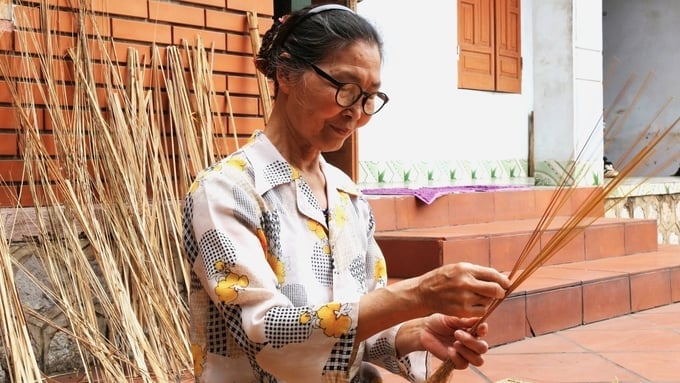
Mrs. Bui Thi Man (Yen Duc commune, Dong Trieu town) is choosing straws with beautiful colors and standard toughness to braid brooms. Photo: Thanh Phuong.
Visiting the home of Mrs. Bui Thi Man (Yen Duc commune), we had the opportunity to hear her recount her 60-year journey with the craft of traditional broom - making.
"From the age of 10, I was taught by my grandparents and parents how to select each piece of straw, and how to weave and braid them to make complete brooms. Practicing this craft requires not only skill but also meticulous attention to detail in every step. The traditional broom - making craft has sustained my family for a long time", Mrs. Man reminisced.
The type of straw chosen for broom-making must be glutinous rice straw, which is harvested only once a year in October. After being collected, the straw is bundled into small heaps and sun - dried for three days to maintain its flexibility and color.
In the next step, the core inside each straw is removed and tied into small clusters called "straw bunches". Five straw bunches are braided together to make one broom, with the size of the bunches varying depending on the size of the broom.
According to experienced craftsmen, making a large broom takes about two days, while a small broom can be completed in 15 to 20 minutes. Currently, the price of a large broom is 2,8 USD, and a small broom costs 1 USD.
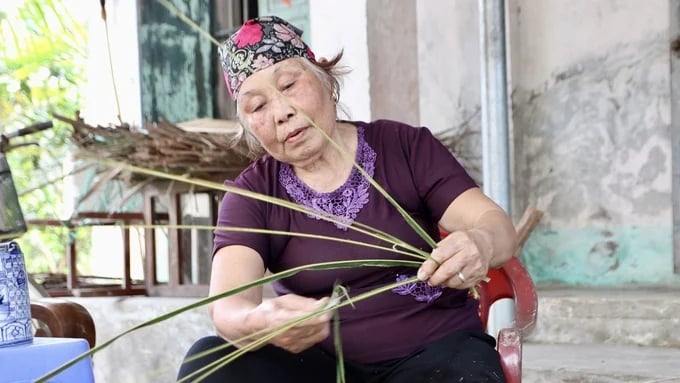
The coconut leaves will be stripped of their leaves, the trunk will be kept and then dried in the sun for about 2 hours, then used to make brooms. Photo: Thanh Phuong.
Not only are straw brooms made, but many households in the village also produce brooms from areca palm leaves and coconut fronds. Every day, Mrs. Cao Thi Lien (Yen Duc Commune) goes to the fields and ditches to collect fallen areca palm fronds and coconut leaves, then she loads onto her vehicle to bring home.
The coconut fronds are stripped of their leaves, leaving only the central part, which is then sun - dried for two days. Next, they are bound into small bundles and tied together with rubber bands. After several processing steps, a coconut broom is sold for approximately 1 USD.
“You have to have strong hands and technique to be able to tie a broom. Doing this not only requires perseverance but also requires skill in stripping the leaves and not stripping the stem so that the broom can be of the best quality. Now that I’m older, I can only make about 15 brooms a month, which provides a small additional income to help cover my living expenses", Mrs. Lien shared.
In recent years, the traditional broom - making craft has gradually declined due to a lack of younger generations to carry it on, leaving only a few elderly individuals who still cherish the craft. This is partly because the meticulous nature of the work and the income do not correspond with the effort and time invested, making young people enthusiastic.
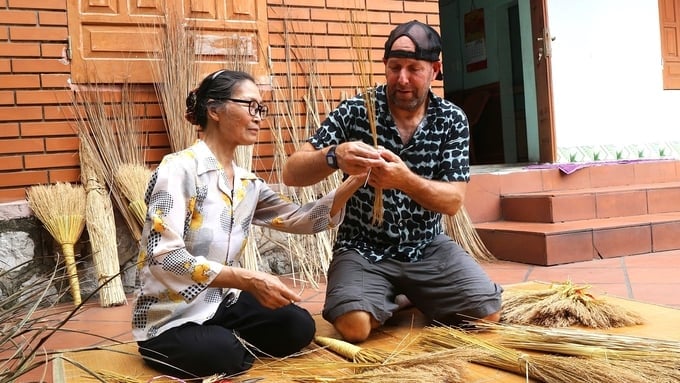
Mr. Lior (a tourist from Israel) enjoyed being able to braid a complete straw broom himself. Photo: Thanh Phuong.
Since 2013, the Yen Duc village tourism model has officially been operational, focusing on tourism experiences related to agricultural life, traditional crafts, and local culture. As a result, many households have registered to participate, collaborating with tourism organizations to create unique local tourism products, including the promotion of traditional broom - making.
In an interview with the Vietnam Agricultural News, Mrs. Bui Thi Man shared: "My family was one of the first to register to collaborate with the tourism organization to showcase traditional broom - making. Through this, I have had the opportunity to introduce the culture, identity of our local area, preserve and protect the broom - making craft from the risk of decline and extinction".
From the risk of decline, traditional brooms now have an additional important "mission" in tourism development, spreading local culture. Many foreign visitors, after experiencing broom - making, are often very excited and express admiration for the meticulousness and skill of Vietnamese artisans.
After finishing the broom-making experience in Yen Duc village, Mr. Lior (a visitor from Israel) enthusiastically said: "This is my first time in Vietnam, and I really enjoy the peaceful rural scenery here. I am very impressed with the traditional broom - making method of the Vietnamese people. Since I was unfamiliar with it, I was quite confused at first. I look forward to having more opportunities to come here and further explore the local culture and identity".
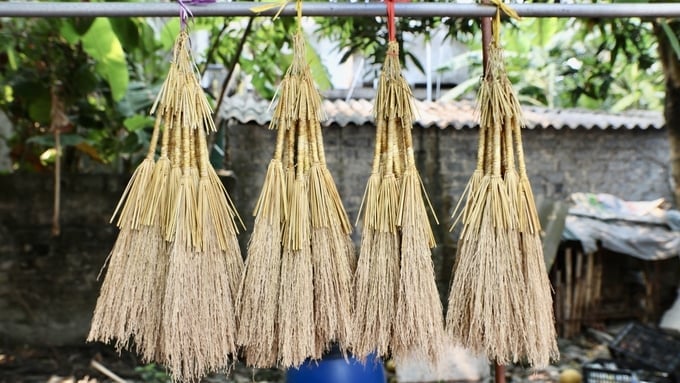
Traditional brooms now have an additional important "mission" in tourism development, spreading local culture. Photo: Thanh Phuong.
Mrs. Duong Thi Men, Deputy Director of Yen Duc Rural Tourism Joint Stock Company, stated: “Before the COVID19 pandemic, we had a large and steady number of visitors. Currently, the tourism site welcomes an average of 50 to 60 guests per day, with some days hosting groups of 200 to 300 visitors. The peak season runs from August to April of the following year. With the community tourism model, we organize various activities such as catching fish with nets, planting rice seedlings, harvesting rice, and especially traditional broom - making".
Mrs. Men noted that, during the traditional broom - making activity, locals will introduce and guide visitors through each step of the process and assist them in creating a complete broom on their own. This model not only helps in developing the traditional craft but also provides income for local farmers. Everyone is very pleased and enthusiastic when they get to make a traditional broom with their own hands.
With the integration of the community tourism model, the traditional broom-making craft in Yen Duc Commune has the opportunity to be "revived", opening up many potential development avenues. Mrs. Tran Thi Sau, Vice Chairman of Yen Duc Commune People's Committee, said: "Since the introduction of community tourism and experiential tourism, some families have partnered with tourism organizations to preserve and promote traditional crafts, including broom - making. Recently, this traditional craft has been extended to children and workers during off - peak agricultural seasons, creating a stable source of income while also contributing to the preservation of the traditional craft".
Translated by Phuong Linh
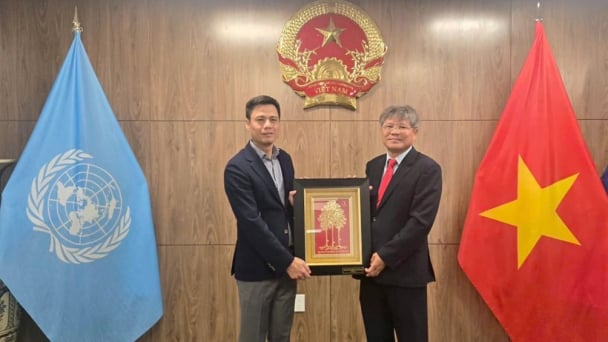
(VAN) VRG recently conducted a visit and working trip to the United States to demonstrate its efforts in redefining the role of rubber enterprises in the global value chain.
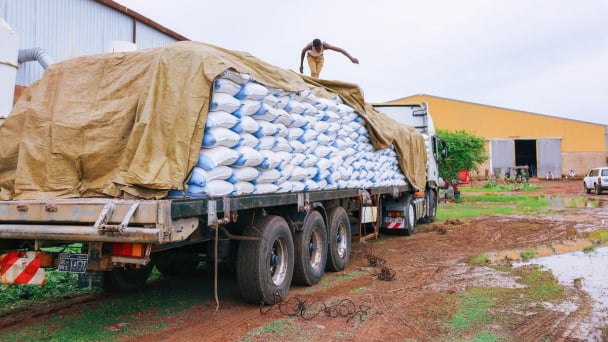
(VAN) In 2024, over 295 million people across 53 countries and territories faced acute hunger—an increase of almost 14 million people compared to 2023, while the number of people facing catastrophic levels of hunger reached a record high.
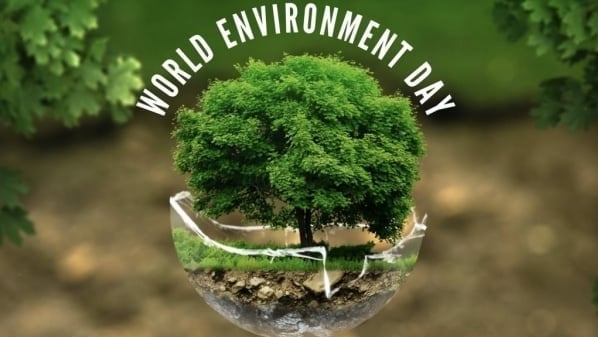
(VAN) World Environment Day 2025 (June 5) carries the theme 'Beat Plastic Pollution' continuing to emphasize the global urgency of addressing the plastic waste crisis.
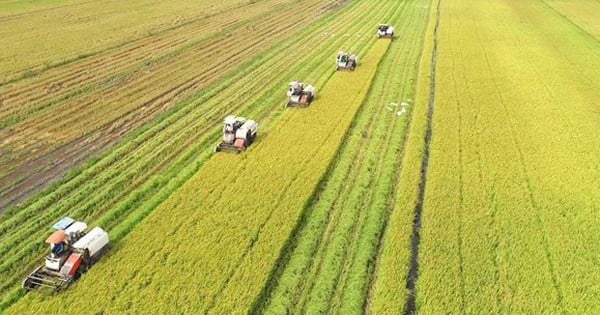
(VAN) This was the assessment shared by experts at the workshop titled 'Assessing the Role and Potential of Low-Emission Rice Production Systems in Vietnam,' held on the morning of May 19.

(VAN) Cai Rong Port is the fisheries control center of Quang Ninh, helping to monitor fishing vessels, combat IUU fishing, and remove the EC's 'yellow card'.
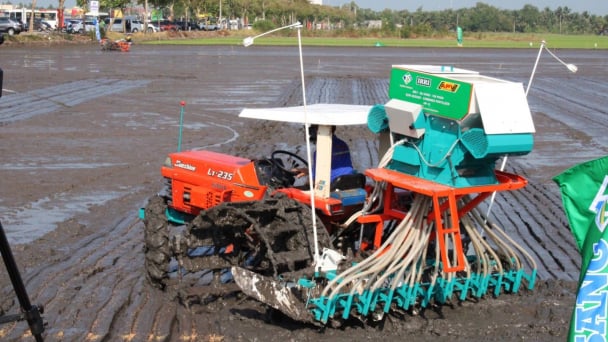
(VAN) The German Agricultural Society (DLG) explores the possibility of establishing a mechanization service center in Vietnam’s Mekong Delta to support farmers in accessing and utilizing advanced machinery.
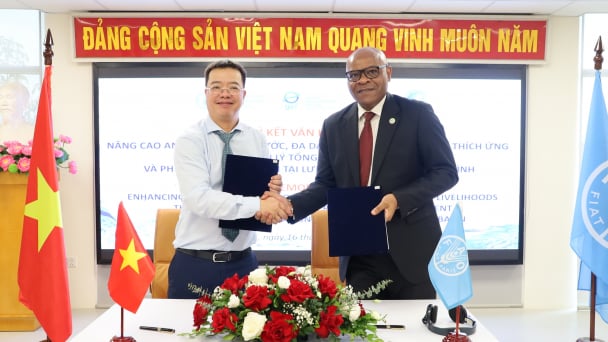
(VAN) On May 16, the Department of Water Resources Management, in collaboration with the Food and Agriculture Organization of the United Nations (FAO), held a signing ceremony for the GEF-8 project document.